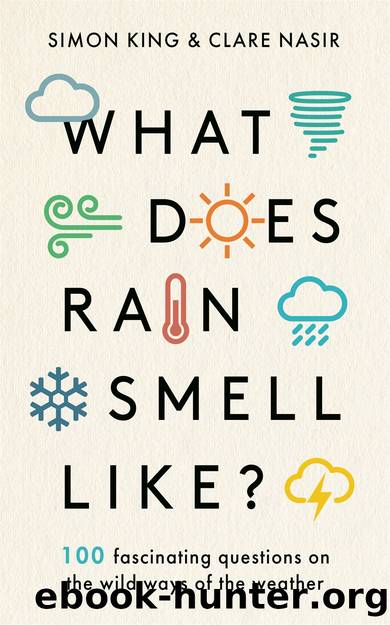What Does Rain Smell Like? by Simon King

Author:Simon King
Language: eng
Format: epub
Publisher: Blink Publishing
Published: 2019-08-15T00:00:00+00:00
WHY WOULD YOU FLY INTO A HURRICANE?
Accurately forecasting tropical storms and hurricanes is vitally important for knowing where they are going to impact. Without taking proper action, a hurricane can cause widespread destruction, injury and death. It is also important economically to know when and where a hurricane might hit as damage can cost the government and insurance companies billions of dollars. While weâll cover the monitoring and forecasting of hurricanes in this chapter, the process is very similar for typhoons and cyclones.
Before we construct a weather forecast, an accurate picture of the state of the atmosphere is crucial. There are many methods to record weather observations around the world, from the surface and sky. Since the introduction of satellites in the 1980s, weâve gained a far more detailed representation of the atmosphere, as this technology can monitor conditions over the oceans and remote regions of land, places where we canât physically get to on the ground.
Before the introduction of satellites, we had a good network of weather observations from the land but only very limited ones at sea via ships and ocean buoys. The problem with this was that hurricanes form and develop over the ocean, the one place where we simply couldnât measure conditions properly. It was in 1943 when the first manned reconnaissance flight flew into a Category 1 hurricane that threatened Galveston, Texas. The US now have a dedicated team of âhurricane huntersâ who fly out into the Atlantic or eastern Pacific and take meteorological measurements of developing storms and hurricanes.
In the early days, the hurricane hunters would be tasked with flying into storms with an array of onboard instruments that measured wind and atmospheric pressure in all parts of the storm. It was these measurements that would a) determine the intensity of the storm and b) provide data that would go into the forecast computer models to give a projection of its track and development. It is one thing flying into a developing tropical storm that might have wind speeds of 64mph or so around its centre, but these hurricane hunters would also need to fly into the eyes of major hurricanes that had sustained wind speeds of over 157mph, with gusts much higher than that.
You may think that these people are crazy, I mean, why would you want to fly into the most destructive weather system on Earth? Well, those who do it are very humble and pragmatic about it. The key thing for them is to avoid the severe turbulence in the storm â the up and down winds that might give you a bumpy ride at times on a commercial flight. In a hurricane, itâs these up and down winds that could potentially break the wings off an airplane. The pilots can track where the severe turbulence is located using onboard instruments and navigate around it. While they will then be flying in wind speeds and gusts in excess of 160mph in the strongest hurricanes, these are straight line winds and something even commercial aircraft are used to handling.
Download
This site does not store any files on its server. We only index and link to content provided by other sites. Please contact the content providers to delete copyright contents if any and email us, we'll remove relevant links or contents immediately.
How to Do Nothing by Jenny Odell(3237)
A Forest Journey by John Perlin(3029)
The Plant Messiah by Carlos Magdalena(2885)
Babylon's Ark by Lawrence Anthony(2624)
The ESV Study Bible by Crossway Bibles(2507)
Energy Myths and Realities by Vaclav Smil(2442)
Fatal Storm by Rob Mundle(2177)
Abbey in America by Murray John A(2051)
Witness Tree by Lynda V. Mapes(1893)
Brokeback Mountain by Annie Proulx(1785)
Client Earth by James Thornton(1742)
Shadows on the Gulf by Rowan Jacobsen(1721)
Coming Back to Life by Joanna Macy(1689)
Cosmos by Carl Sagan(1684)
Mycelium Running: How Mushrooms Can Help Save the World by Paul Stamets(1648)
Water Rights and the Environment in the United States by John Burch(1646)
Ten Billion by Stephen Emmott(1620)
The overachievers by Robbins Alexandra(1534)
Ecological Intelligence by Daniel Goleman(1511)
